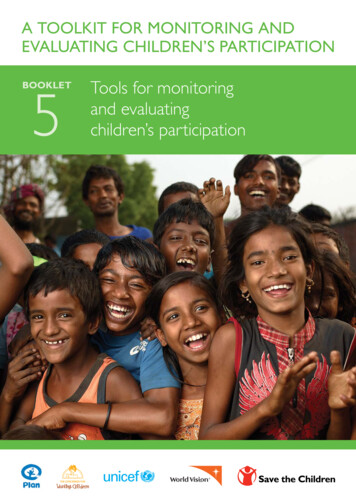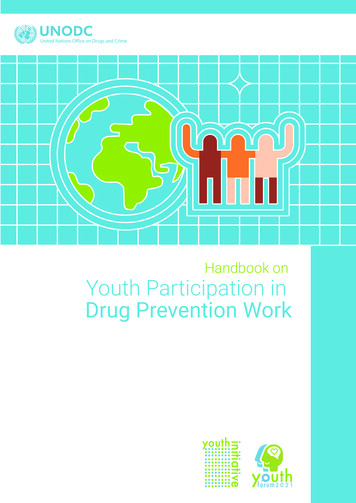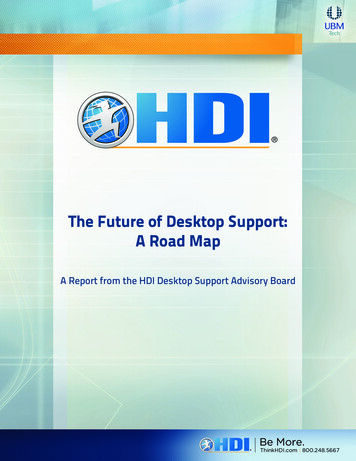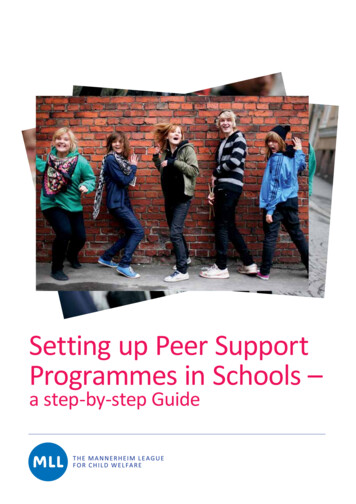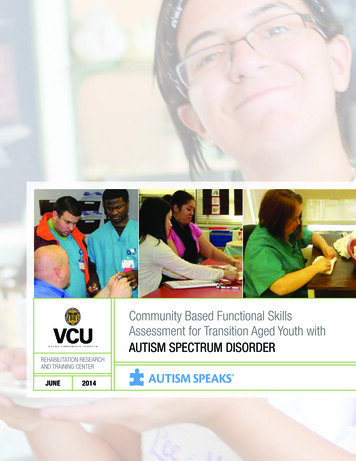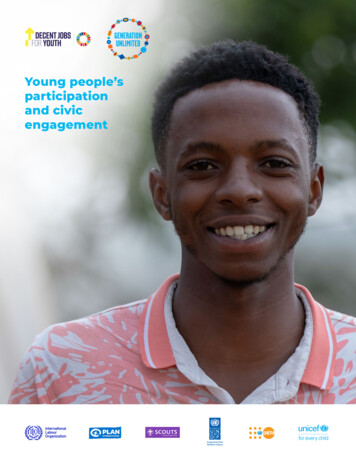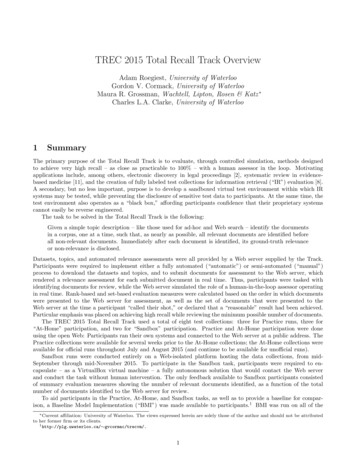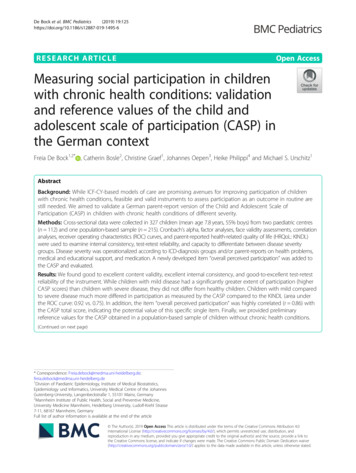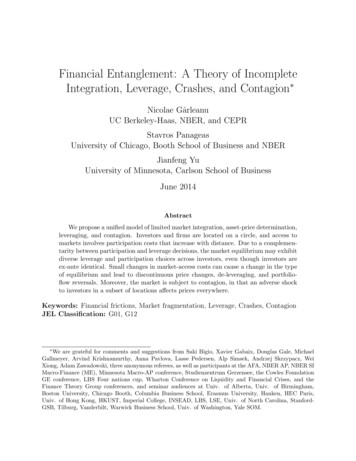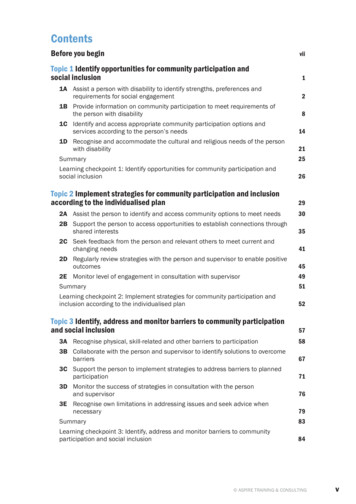
Transcription
ContentsBefore you begin viiTopic 1 Identify opportunities for community participation andsocial inclusion 11A Assist a person with disability to identify strengths, preferences andrequirements for social engagement 21B Provide information on community participation to meet requirements ofthe person with disability 81C Identify and access appropriate community participation options andservices according to the person’s needs 141D Recognise and accommodate the cultural and religious needs of the personwith disability 21Summary 25Learning checkpoint 1: Identify opportunities for community participation andsocial inclusion 26Topic 2 Implement strategies for community participation and inclusionaccording to the individualised plan 292A Assist the person to identify and access community options to meet needs 302B Support the person to access opportunities to establish connections throughshared interests 352C Seek feedback from the person and relevant others to meet current andchanging needs412D Regularly review strategies with the person and supervisor to enable positiveoutcomes 452E Monitor level of engagement in consultation with supervisor 49Summary 51Learning checkpoint 2: Implement strategies for community participation andinclusion according to the individualised plan 52Topic 3 Identify, address and monitor barriers to community participationand social inclusion 573A Recognise physical, skill-related and other barriers to participation 583B Collaborate with the person and supervisor to identify solutions to overcomebarriers 673C Support the person to implement strategies to address barriers to plannedparticipation 713D Monitor the success of strategies in consultation with the personand supervisor 763E Recognise own limitations in addressing issues and seek advice whennecessary 79Summary 83Learning checkpoint 3: Identify, address and monitor barriers to communityparticipation and social inclusion 84 v
Topic 1In this topic you will learn howto:1A Assist a person withdisability to identifystrengths, preferences andrequirements for socialengagement1B Provide information oncommunity participation tomeet requirements of theperson with disability1C Identify and accessappropriate communityparticipation options andservices according to theperson’s needs1D Recognise andaccommodate the culturaland religious needs of theperson with disabilityIdentify opportunitiesfor communityparticipation and socialinclusionSupporting a person to become an active, involvedand social member of their community requirescareful planning. You should work with the personwith disability you are supporting to set goals andselect appropriate options that represent theirdesires, preferences and interests. You can helpa person work through the stages of planning,organising and implementing an activity plan. Thisplan will build social competency skills and supporta person in becoming actively involved in planningtheir own recreation, hobbies and social pursuits.Remember to allow your support to be directedas much as possible by the person with disability,although there will be situations where input fromothers, such as family members, is required. 1
CHCDIS003 SUPPORT COMMUNITY PARTICIPATION AND SOCIAL INCLUSIONCommunication abilitiesBeing able to communicate through words, symbols, pictures, gestures, signing or acomputer-based systemEmotional abilitiesBeing able to manage and express emotionsSensory abilitiesBeing able to see, hear and touchUnderstand the context of informationInformation about how to meet an individual’s requirements may already be knownand documented, which means you may not need to recreate it. You do, however, needto ensure you have appropriate permission to access information from another sourceand that it is relevant to the context in which you are going to use it.The type of information included depends on the age and abilities of the person, onthe type of setting the document is prepared for (such as a school, play group, teenageactivity group, adult social group or senior citizens’ program) and on the location of thesupport.Support can be provided in a range of different locations, as listed below.Locations where support is providedXXAged care facilitiesXXDisability-specific service settingsXXIndividual, private homesXXCommunity centresXXRespite programs conducted in a centreXXRespite programs conducted in varying locations according to people’s requirementsXXHospitalsXXNeighbourhood houses, play groups or play centresUse the person’s planExisting plans and documentation will vary widely depending upon the frameworksand systems of support and funding currently being used by a person. It may beappropriate to use an existing plan or document, but it is vital that this is done inaccordance with relevant legislation such as the Privacy Act 1988 (Cth). If you needadditional information you should source this from the person themselves, or fromrelevant others such as family members, case managers, mental health workers orallied health professionals. Remember that when you are writing or using a planningdocument you should focus on using language and terminology which focuses onstrengths and abilities and which is clear, concise and appropriate.6 ASPIRE TRAINING & CONSULTING
CHCDIS003 SUPPORT COMMUNITY PARTICIPATION AND SOCIAL INCLUSION1BProvide information oncommunity participation to meetrequirements of the person withdisabilityOnce a person’s activity needs and requirements have been identified, it is importantto provide this information to the person so they understand the options, networks andservices available to them. They can then begin to make informed choices about theirpreferences.It is important that people with disability are given sufficient information so they canmake choices about community participation options, networks and services which fitbest with their own requirements and preferences. Insufficient information could leadto a poor activity choice or the person’s needs not being fully met. Information shouldbe both general (options available) and specific (details on participation).Options may include the following.The type of activitySome activities may be a very comprehensive, while similar activities may only offerbasic elements. Both options should be discussed with the person.The costThe activity may be free for the person or there may be a cost involved. If the cost istoo high for the person, they may prefer a different or more basic activity.The locationThere may be an activity in the local community hall, or the person may have to travelto another suburb. If transport is not a problem, then the person may choose theone for which they have to travel because the activity itself is more comprehensive orsuitable.Participation levelMany activities can be undertaken at different levels of participation.The timingThe timing of an activity needs to fit with other lifestyle and work or studycommitments.Person-centred practicePerson-centred practice is a philosophical concept which underpins much of the workwithin the community services sector. It is an approach that places the person at thecentre of the service planning and provision, with all aspects of support stemmingfrom that point.8 ASPIRE TRAINING & CONSULTING
CHCDIS003 SUPPORT COMMUNITY PARTICIPATION AND SOCIAL INCLUSIONVision impairmentA person with vision impairment:XXmay not be aware that someone is talking to themXXmay lack the accepted norms of body language and habits of a sighted personXXmay only be able to absorb information in auditory form or through brailleXXmay be frustrated by others who talk loudly to them as if they cannot hear.Things to remember:XXUse the person’s name to gain their attention first.XXSpeak in the same way as you would to a sighted person.XXProvide information through spoken language or braille.XXIntervene if needed to support a conversation the person is having with anotherperson, if they have previously asked you to do so.Identify who to share information withCommunicate first with the person you are supporting. Ensure you direct your attentionand interaction towards the person and look directly them. Avoid speaking to others,such as family members, rather than directly to the person. This can be disrespectfuland does not reflect a strengths-based approach as it does not build capacity orcapitalise on existing strengths of the person.However, there are some times when communication may need to be directed toothers.People who may need communication to be directed to othersXXChildrenXXPeople with a court order in place that requires a parent or guardian to makedecisions on their behalfXXPeople who have a disability that makes it difficult or impossible for them tomake sound decisions without assistanceXXPeople who prefer to communicate through an advocateShare informationEstablish who communication should be directedto (if not the person themselves) when sharinginformation, such as a parent, guardian, family memberor advocate. These people are often experienced insharing information with the person and may be able toeffectively communicate ideas and concepts that youmight not be able to yourself. It is preferable to havethe person present and involved in the conversation asmuch as possible. The person may be able to join in part of the conversation or useyes/no responses, visual or electronic communication methods, or other strategies tohelp them be a part of the conversation.12 ASPIRE TRAINING & CONSULTING
CHCDIS003 SUPPORT COMMUNITY PARTICIPATION AND SOCIAL INCLUSIONVolunteer driversBenefits:XXThe cost is low.XXDrivers are often experienced in helping people with disability to access a vehicle.XXIt can be pre-arranged.XXIt is another avenue for developing social skills and social contact.Limitations:XXOnly a limited number of people can travel together.XXThe person needs to rely on the checking procedures of the organisation toensure the volunteer is a safe and suitable person to be with.XXSome people may not be comfortable with a volunteer providing support.Could be suitable for:XXpeople who wish to travel to destinations where public transport is not availableXXindividual activitiesXXpeople who are relatively independent and confident in dealing with a volunteer.Identify and access mobility aidsThere are many different types of mobility aids. Theseare usually specific to the individual person and areoften made specifically to suit their needs. Supportworkers need to ensure the individual is aware of howa particular mobility aid functions, and that they havea good understanding of its purpose. Some examplesof mobility aids are electric wheelchairs, manualwheelchairs, scooters, walking frames and crutches.Training may be available from a physiotherapist oroccupational therapist.Sometimes people may require support or referral to other agencies to obtain newmobility aids or to seek additional funding for changing needs or requirements. Theymay be able to access funding through a government program such as the VictorianAids and Equipment Program (A&EP) or the Community Aids and Equipment Programin Western Australia (CAEP).Identify and access communication aidsSome people use a communication aid for expressive and receptive communicationwith others. These aids have been designed to suit the communication needs of theindividual. There may be instructions or prompts to encourage others to converse withthe person using the aid.If you are working with a person who has a communication aid, take the time tolearn how to use it competently and efficiently, and how to help the person accessand maintain their aid. As a support worker, you need to be able to adapt yourcommunication skills to meet the needs of the people you support. You must ensurethat you can understand and share ideas about daily tasks, personal care needs,16 ASPIRE TRAINING & CONSULTING
Topic 2Implement strategies for community participation and inclusion according to the individualised planSocialSportingDevelop social skills such asinteracting with others, making newfriends, learning to communicatein social situations and gainingconfidence by participating inactivity programs, respite activities,out and about programs, artsand crafts programs or travel andrelated activities.Build skills, knowledge and abilitiesin participating in sports that canassist with increasing fitness,muscle strength, endurance andother health parameters.RecreationLiving skillsLearn to participate in recreationpursuits and hobbies or leisureactivities that can be completedindividually or in groups.Recreation activities can buildsocial and physical skills and assistwith developing confidence and theability to interact and participatesocially within the community.Sporting activities can includewater- and land-based sportswith participation in specificallydesigned groups for people withdisability, or in open or mixedsettings or competitions.Enhance abilities related toactivities of daily living such asmanaging personal finances, usingpublic transport or knowing what isexpected in social situations.Living skills outcomes can beachieved through activities suchas going shopping, visiting alibrary, reading a map to locate aparticular street or using personalorganisation skills to plan for andattend an event in the community.Access optionsMany community options can be selected to meetindividual needs and preferences and it is important tothink carefully about which ones are most appropriatefor the person. Keep in mind that if the person ispurchasing support directly they need to consider thecost of various choices. Transport needs, timing andease of access should all be considered in helpinga person plan for how they will access a communityoption in a practical sense. Remember that sometimes things that look good on papersimply do not work when it comes to implementation; it is at this point that some clearthinking, problem solving and common sense can be particularly useful.Meet requirementsYou may be responsible for identifying and assisting a person in accessing communityoptions to meet their needs, or you may be asked to provide services where youare employed directly or indirectly by the person as part of an individual fundingpackage. If you are asked to help complete, or implement, a community access planit is important to know what to include and how to link activities to areas of need orspecific requirements. 31
Topic 2Implement strategies for community participation and inclusion according to the individualised planHere are some services for people with complex or multiple disabilities.Services for people with complex or multiple disabilitiesScope – for people with a range of disability caused by cerebral palsyAcquired Brain Injury Slow to Recover program – for people who have a catastrophicbrain injury with slow progress and recoveryVictorian Dual Disability Service – for people with an intellectual disability andmental health conditionAustralian DeafBlind Council – for people who are both deaf and blindInvolve the family in accessing community optionsIn many cases, it is appropriate to involve family members in accessing services andmaking decisions about options in the community, particularly if you are working witha child. The family may have had a service recommended to them by a friend or theymay have done research and want to ask your opinion about a service provider theyhave found. In the case of adults, the role of the family may become one of providingencouragement and support rather than decision-making.Family is also a valuable resource in helping a person with disability to accesscommunity services by providing assistance for no cost and by being present at timesplaces that others may be unable to accommodate, often on short notice.Family members may be able to:provide transportXX provide supervisionXX provide personal care needsXXmake day-to-day arrangementsXX liaise with service providers.XXWork with others in accessing community optionsThere are many other people who may be involved in identifying and accessingcommunity options which meet the needs of an individual’s plan. These people maybe included in planning and discussion meetings or they may provide direct servicesto meet specific goals or outcomes within the plan. Some people may be involved fora short time in sharing information, providing training or developing programs andservices during an initial phase.To work well with relevant others, it is important to think about your own work role andhow you can best reflect your organisation in a professional, competent manner.To work effectively with relevant others, always:make sure you are polite, courteous and professional in your interactionsXX be punctual for meetingsXX ensure you are well presented and dressed appropriatelyXX prepare for meetings by reading and understanding material providedXX be willing to ask questions and ensure you understand what is going onXX allow time for others to speak and ask their own questionsXX work in a way that creates a professional, competent image of your workplace.XX 33
CHCDIS003 SUPPORT COMMUNITY PARTICIPATION AND SOCIAL INCLUSIONLink people with shared interests to specific programsIt also helps to learn more about the specific services that can help a person withdisability to form links with shared interest groups or activities, community groups orindividuals.Here are two examples.Respite programsWhen offered on an individual basis, respite programs can have the double benefitof allowing a family carer to take time off for their own activities, as well as helping aperson to link with a shared interest activity or person.Access programsPrograms such as Arts Access help people with disability or disadvantage toaccess arts and the theatre through discounted tickets, information about Auslaninterpreted performances, captioned performances, information about wheelchairaccessible venues, appropriate seating choices in a venue and companion cardinformation.Encourage relationships with shared interest groupsRelationships are often based on conversation or a shared activity. As a supportworker, it can be your role to give a developing relationship a bit of a helping hand. Thisis often the case when you are working with people who have limited social experience,or who lack social skills and communication abilities. However, make sure the peopleinvolved don’t start to rely on you to do all the talking. If you are not careful, you mayfind that you become the active participant in a group setting, rather than the personyou are supporting.Here are some ideas for helping to get a relationship started.Ideas for helping to get a relationship started36XXStart a conversation with another person and assist the person to join in.XXAsk questions that are directed at a number of people in a group.XXPrompt the person to participate directly in a conversation by asking questionsyou know they can answer easily.XXBegin conversations about topic areas you know are of interest to the personand others.XXRole model appropriate communication skills.XXAct as an interpreter to begin a conversation, for example using key word signing.XXEncourage other people in the group to assist with a task when you are notthere; you may need to find an excuse to leave for a moment.XXShow other people how to use communication equipment such as alphabetboards or electronic devices. ASPIRE TRAINING & CONSULTING
CHCDIS003 SUPPORT COMMUNITY PARTICIPATION AND SOCIAL INCLUSIONSay hello to a neighbour, and make sure you introduce the person you are supportingand explain your own role as a support worker or personal carer. Encourage aconversation between the person and the neighbour, if it seems appropriate, and fadeout your own involvement if the conversation is going well.Of course, it is vital to remember that interactionswith the neighbours are not always appropriate or agood idea. Use your common sense and judgmentto appraise the situation, and weigh up the benefitsagainst the potential risks. In some situations, it maybe wiser to pay only limited attention to the neighbours,or to make sure a person you are supporting is awareof whom they should not interact with. Remember thatpeople with disability are vulnerable in many situations,and there are those in our society who will deliberatelyprey upon their vulnerability.Best practice inclusion principlesThe concept of universal design has become integral in the way new fields, productsand services are designed across many areas of daily life. Best practice inclusionmeans providing a seamless, fully accessible environment, service or product whichcan be used easily by all people rather than one which has just been designed for aperson with disability. For example, a playground mightbe designed to be accessible to children who use amobility aid as well as those who are ambulant. An artcentre might ensure it has fully accessible toilets anda wide range of programs to meet the needs of patronswho have specific requirements.Best practice inclusion means ensuring programs andservices operate in a way that is deliberately accessibleand inclusive to people of all abilities. It is not sufficientto adopt a responsive approach where strategies aredeveloped to promote inclusivity only after a person with a disability attempts touse them. Best practice means taking a proactive approach so that managementdecisions, systems, processes and facilities are made accessible and inclusivebeforehand, so that the environment is welcoming and appropriate for everyone whowishes to participate.You can learn more about inclusive play spaces, including a map of accessibleplaygrounds, at www.inclusiveplayspace.com.Capacity building in the communityCapacity building is an important concept in community services practice. It meansworking in a way that shifts skills, knowledge and confidence from those who havespecialist knowledge (such as those working in community services) to providers inthe wider community, such as sporting clubs. Capacity building is important because itstrengthens local groups and organisations and ensures they are better able to providea wide range of options and services to people who with disability as well as to thosewithout.38 ASPIRE TRAINING & CONSULTING
Topic 2Implement strategies for community participation and inclusion according to the individualised plan2CSeek feedback from the personand relevant others to meetcurrent and changing needsFeedback can be useful in helping you take action andmake changes to how you provide support to a person.Feedback can come from a number of sources, such asthe person themselves, family members, colleagues,supervisors or relevant others. Feedback may suggestthat a change is required in some aspect of support,such as a need which has increased over time. It canalso indicate when an activity or community option isworking well and is currently meeting the needs andwants of the person.Actively seeking feedback is useful in ensuring the support provided is alwaysappropriate and represents best practice. Feedback can be obtained formally orinformally, depending on the situation.Informal feedbackInformal feedback can be useful in allowing you to make small but important changesto your daily work practices. Informal feedback can come from a variety of sources.Consider how you respond to feedback; remember it is not usually intended as acriticism of your work but rather as a suggestion for how things can be improved.For example, a person might tell you they are finding it very tiring going out for solong during a recreation activity. You could use this feedback to help them plan andorganise a shorter activity which will not be so tiring.Examples of feedback that might be provided by different people:The person receiving services may provide specific feedback about the nature,timing or type of activities which are provided.XX A family member may comment on a changing need or issue for the person andask you what you have noticed.XX A colleague may discuss with you a problem they have noticed so you can plan asolution together.XX An advocate may tell you the person has asked them to provide informal feedbackto you about how much they are enjoying their activities.XX A mental health nurse may suggest a better way of responding to an upsettingcomment made by the person.XXFormal feedbackFormal feedback can be sought from the person you support, family members,colleagues, your supervisor or relevant others involved in supporting the person.Formal feedback is typically provided in a different way to informal feedback andwithin a different time frame. You should feel confident in seeking formal feedbackas it is a good way to learn and to improve your skills and knowledge. Try and see 41
Topic 2Implement strategies for community participation and inclusion according to the individualised planSeek support from your supervisorYou may require support from your supervisor to help you identify and resolve communityparticipation strategies that might not be working for achieving positive outcomes for aperson. Your supervisor is likely to be more experienced and have better knowledge oflocal resources and appropriate strategies that might work for a person. They are alsoable to authorise or instruct you in how to approach other agencies or service providersas required to seek additional support for a person, or to make a referral.Here are some ways you could approach your supervisor to ask for assistance andsupport.Approaching your supervisor for assistanceEmailSend an email detailing your concerns and asking specific, clear questions so yoursupervisor can respond in writing.Team meetingAsk for assistance during a regular team meeting where your supervisor is present;this approach could also support others in your team.Mobile phoneIf the matter is urgent, use a mobile phone to contact your supervisor directly for animmediate response.Informal conversationRaise your questions during an informal conversation where you can talk for anextended period if needed.Informal conversationRaise your questions during an informal conversation where you can talk for anextended period if needed.ExampleFormal meetingRequest a formal meeting with your supervisor and take notes about their responses,information and instructions.Amend a planRachel provides support to Chantelle during regular weekly outings. Chantelle hasmultiple sclerosis and her condition changes from time to time. Chantelle has justbegun a new medication, and Rachel reads this information in her plan.During an outing, Rachel notices Chantelle appears less focused and is quite sleepyand distracted. She has trouble staying awake and Rachel needs to provide muchcloser support and supervision than normal.Rachel is aware Chantelle’s family are away on holidays next month and Chantelle willbe receiving 16 hours of in-home care per week for a few weeks.Rachel refers the issue to her supervisor via email and suggests a meeting be calledwith Chantelle and her family before they leave for holidays. Rachel suggests theplan be reviewed with an emphasis on medical details regarding medication and anyeffects on Chantelle’s behaviour and mood. The meeting is called for the followingweek. Chantelle’s doctor provides medication advice and comments via email to sharewith workers and others at the meeting.This information, together with Rachel’s observations, means Chantelle receives goodquality care while her family is away. 47
CHCDIS003 SUPPORT COMMUNITY PARTICIPATION AND SOCIAL INCLUSIONThe role of the supervisorYour supervisor is able to offer advice and direction in situations where you are unsurewhat course of action to take. If you are working with a particular person and you areconcerned about their level of engagement, you should feel confident in approachingyour supervisor to discuss the situation.Here are some things your supervisor might be able to do.Supervisor’s actionsObserve you working with the person and see if they can provide useful feedbackTalk to you about possible strategies that might assistSit in on a discussion session with the person to help you talk to them aboutengagementSuggest reasons that the person’s level of engagement may have changedProvide advice in situations where you feel the person may be at risk of harmA change in engagementGemma has been working with Phil for several months. He has been coming to a dropin arts program and at first seemed to be gaining a great deal from it. He had madesome new friends and was enthusiastic about mastering water colours and pastels.Now he is still attending the sessionsbut his enthusiasm for the activitiesseems to have disappeared. Hearrives later and later each week andis quiet and withdrawn. He no longerinitiates conversation although he isstill content to respond to questions.Gemma decides to speak firstly withPhil and then with her supervisor todecide what to do to help Phil.v1727ExampleGive direct instructions about what you should do in a particular situationPractice task 91. What are four things you might observe if a person is becoming less engaged witha community activity?50 ASPIRE TRAINING & CONSULTING
Topic 3Identify, address and monitor barriers to community participation and social inclusionSignsExample:XXSigns to indicate:XXdirectionXXchange of levelXXlocation of toiletsXXlocation of rooms or buildingsXXhazardsXXentry and exit points.These affect people who:XXare unable to interpret the sign correctly due to a cognitive impairmentXXcannot see the sign due to a vision impairmentXXdo not read and write in English and who also have disability.ToiletsExample:XXToilets with narrow doorwaysXXToilets without grab railsXXToilets that are not identified using raised tactile symbolsXXToilets that have ambiguous or difficult-to-interpret signageThese affect people who:XXuse a wheelchair or scooter that cannot fit through a toilet doorway or manoeuvr
Summary 25. Learning checkpoint 1: Identify opportunities for community participation and social inclusion 26. Topic 2 . Implement strategies for community participation and inclusion according to the individualised plan . 29 2A Assist the person to identify and access community options to meet needs 30
